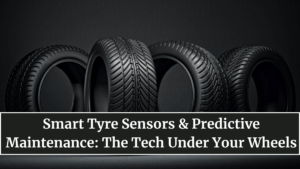Your car’s most essential safety component isn’t the engine or the brakes — it’s the tyres. And now, even they’re getting smarter. The rise of smart tyre sensors and predictive maintenance is revolutionizing the automotive industry, turning ordinary tyres into intelligent data-gathering tools that monitor health, pressure, and performance in real time.
In 2025, cars are evolving into rolling computers — and tyres are no exception. Embedded with IoT sensors and connected to vehicle systems, they can now predict issues before they happen, helping drivers stay safe while reducing downtime and repair costs.

What Are Smart Tyre Sensors?
Smart tyre sensors are tiny IoT-enabled devices embedded inside or attached to tyres that monitor crucial parameters such as:
-
Tyre pressure and temperature
-
Tread depth and wear rate
-
Road surface conditions
-
Load distribution and driving behavior
These sensors continuously send data to the vehicle’s onboard computer, allowing predictive systems to warn drivers of potential failures — from low pressure to dangerous wear patterns.
Unlike traditional TPMS (Tyre Pressure Monitoring Systems), these advanced sensors go a step further. They use machine learning algorithms to analyze trends over time, enabling proactive maintenance rather than reactive repairs.
How Predictive Maintenance Works
Predictive maintenance combines real-time sensor data with cloud-based analytics to forecast when a component — such as a tyre — will need attention.
Here’s how the process typically works:
-
Data collection: Smart sensors continuously capture data on tyre health and driving patterns.
-
Analysis: AI models compare current data to historical patterns.
-
Prediction: The system identifies anomalies indicating potential damage or wear.
-
Action: Drivers receive alerts for inspection, rotation, or replacement before issues escalate.
This proactive approach not only extends tyre lifespan but also enhances overall vehicle safety and efficiency.
The Tech Behind Smart Tyres
Today’s smart tyres integrate several advanced technologies that make them both robust and intelligent:
-
MEMS sensors (Micro-Electro-Mechanical Systems): Ultra-small sensors that detect pressure, vibration, and heat changes.
-
Bluetooth and 5G connectivity: Enables instant communication between tyres and the vehicle’s onboard system.
-
AI and cloud analytics: Predictive algorithms process real-time data to identify upcoming failures.
-
Energy harvesting: Some smart tyres generate power through motion, reducing the need for external batteries.
Together, these technologies create an intelligent tyre ecosystem that “feels” the road, understands driving conditions, and reacts faster than the driver can.
Benefits of Smart Tyre Systems
Smart tyre sensors aren’t just a luxury — they’re rapidly becoming an automotive necessity. Their benefits include:
-
Enhanced safety: Continuous pressure and wear monitoring prevent blowouts.
-
Fuel efficiency: Properly inflated tyres reduce rolling resistance, saving energy and emissions.
-
Lower maintenance costs: Early detection avoids expensive repairs.
-
Longer tyre lifespan: Balanced wear and optimized driving inputs extend durability.
-
Fleet optimization: Ideal for logistics companies managing large fleets with minimal downtime.
For EVs, where energy efficiency is critical, these systems also help maximize driving range by maintaining optimal traction and pressure.
Leading Innovators in Smart Tyre Technology
Automotive giants and tech firms are collaborating to bring intelligent tyre solutions to the market.
| Company | Innovation Focus | Notable Feature |
|---|---|---|
| Bridgestone | Smart Strain Sensor Tyres | Real-time wear detection for EVs and fleets |
| Michelin | Uptis Airless Tyre | Combines sensor data with puncture-proof design |
| Continental | ContiSense & ContiAdapt | Adjusts pressure and tread depth automatically |
| Goodyear | SightLine | AI-powered platform predicting road and weather risks |
| Pirelli | Cyber Tyre | Cloud-connected tyre network for premium vehicles |
These technologies are redefining how vehicles understand road dynamics and respond to changing environments.
The Future of Predictive Maintenance
By 2030, predictive maintenance will become standard in all connected vehicles. Cars will autonomously schedule tyre servicing based on usage patterns and driving behavior.
AI-powered dashboards will visualize tyre wear, road friction, and braking efficiency, giving drivers unprecedented control and peace of mind. Combined with smart infrastructure, future cars may even communicate with city road systems, sharing real-time safety data for better traffic management.
The next generation of smart tyres won’t just carry your vehicle — they’ll guide, protect, and adapt with every kilometer you drive.
Why It Matters
In a world shifting toward automation and connected mobility, smart tyres represent one of the most critical advances in safety and sustainability. By blending IoT, AI, and automotive design, predictive maintenance ensures vehicles stay reliable while reducing waste and energy consumption.
The road ahead is intelligent — and it starts from the ground up.
FAQs
What are smart tyre sensors?
They are small electronic devices installed in tyres that measure pressure, temperature, wear, and other parameters to monitor tyre health in real time.
How does predictive maintenance help drivers?
It forecasts when tyres need service, preventing failures, reducing costs, and improving safety.
Are smart tyre systems available in regular cars?
Yes, premium and mid-segment vehicles are increasingly adopting smart tyre systems, especially EVs and connected cars.
Can smart tyres save fuel?
Absolutely. Maintaining correct pressure and alignment improves fuel efficiency and extends battery range in EVs.
What’s next for smart tyre technology?
Expect AI-driven diagnostics, airless designs, and fully connected ecosystems where tyres self-report issues and schedule service automatically.
Click here to know more.
